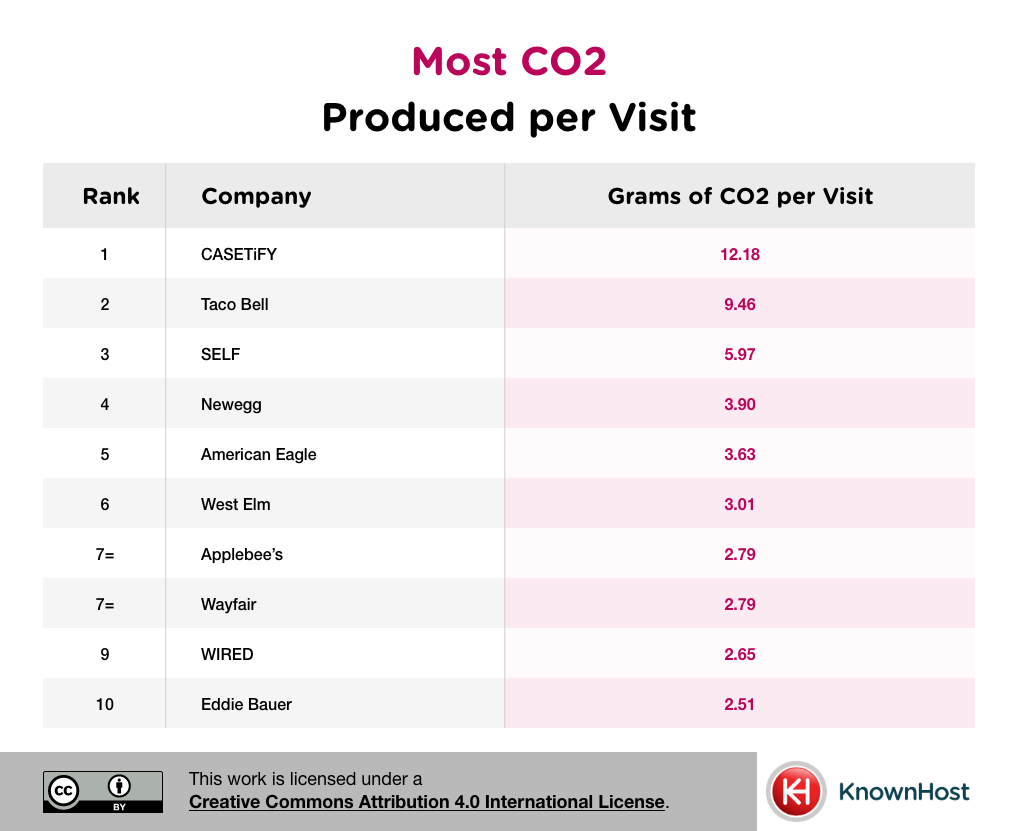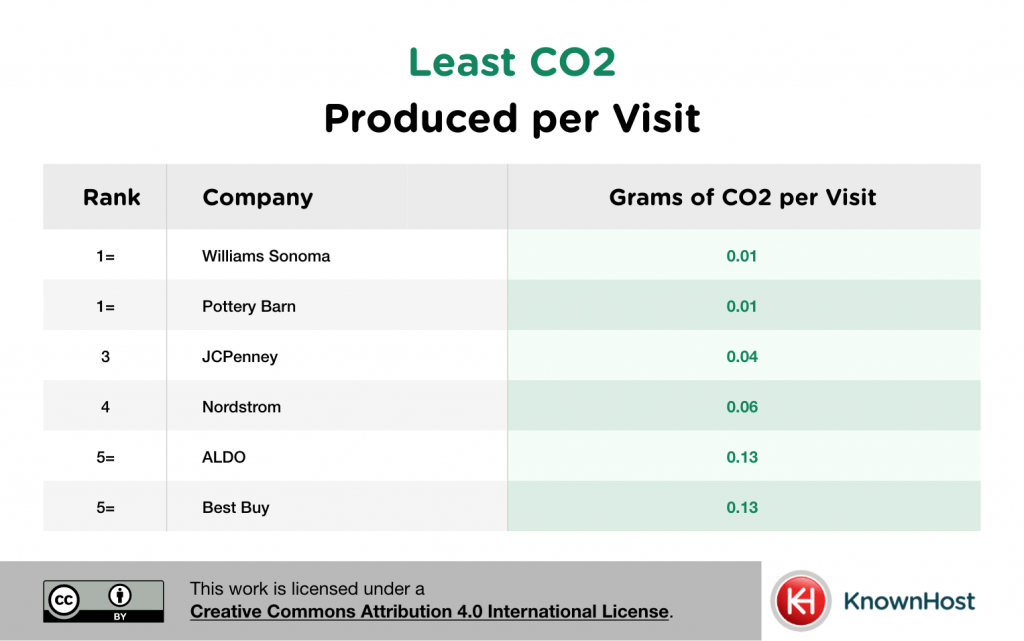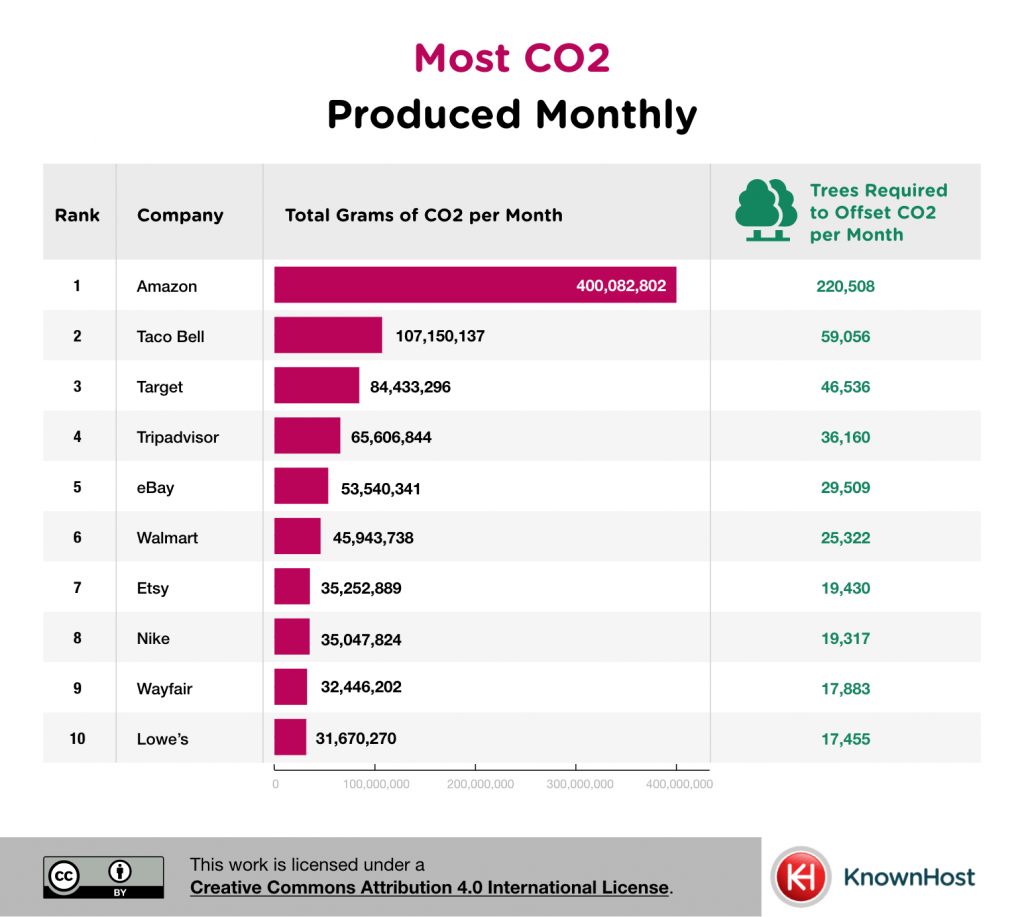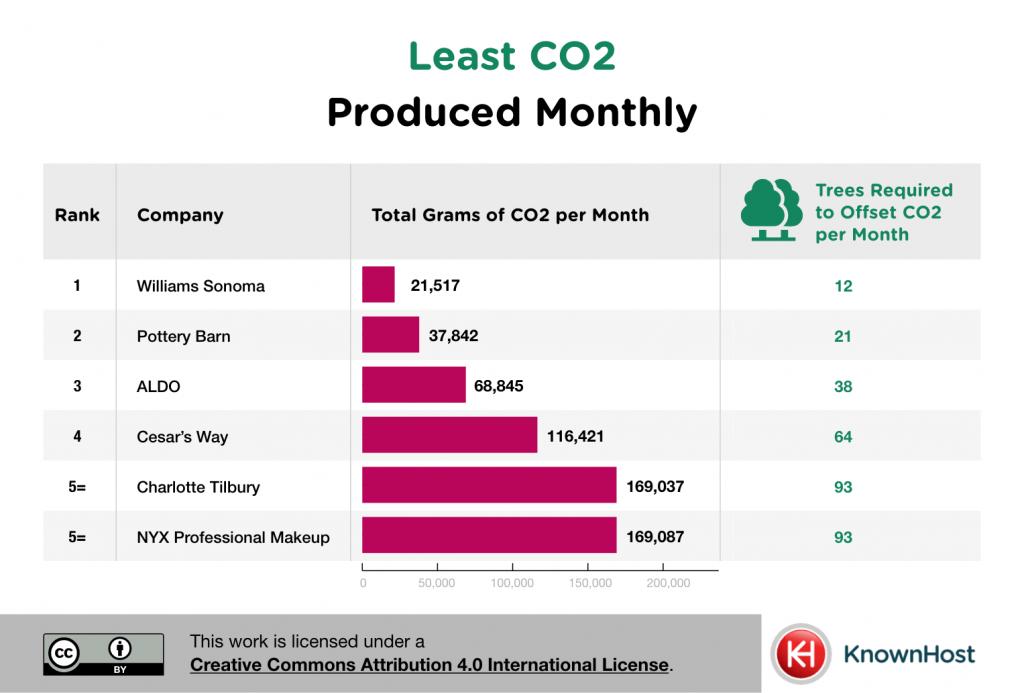The Carbon Footprint of Your Online Shopping
Last Updated: July 13, 2023
In the digital age, online shopping has revolutionized the way we buy products and services. However, this convenience comes at an environmental cost. As more consumers embrace the world of e-commerce, concerns about the carbon footprint associated with online shopping have gained traction. Wired has claimed these websites are killing the planet.
To shed light on this pressing issue, we’ve uncovered the carbon emissions generated by some of the largest online retailers in the United States. Analyzing each company’s CO2 emission through their respective websites has led to valuable insights regarding the environmental impact of our online shopping habits.
Together, we can work towards a more eco-friendly future where e-commerce and environmental responsibility go hand in hand. Though first, we’ll need to understand how our online purchases lead to carbon emissions and what we can do to prevent this before any informed choices can be made.
How Do Websites Emit Carbon Dioxide?
- Web Hosting Servers: Websites are hosted on servers that require electricity to run 24/7. These servers process user requests, retrieve data from databases, and deliver website content to users’ browsers. The energy used to power these servers often comes from fossil fuel-based sources, leading to carbon emissions.
- Data Centers: Data centers house the web servers and networking infrastructure required to operate websites. They use substantial amounts of electricity to maintain optimal temperature and humidity levels for the equipment. This energy consumption can result in carbon emissions, especially if the data center’s power comes from non-renewable sources.
- Content Delivery Networks (CDNs): Many websites use CDNs to distribute their content to users from servers located in various geographic regions. While CDNs can improve website performance and reduce latency, they also increase energy usage and emissions due to the additional servers involved.
- Internet Infrastructure: The internet relies on a vast network of routers, switches, and other networking equipment to transmit data between servers and users. This infrastructure consumes energy and contributes to carbon emissions.
- User Devices: While the direct energy consumption of a user’s device (e.g., laptop, smartphone) is not caused by the website itself, the processing power required to render web pages and interact with the website contributes to the overall energy consumption associated with website visits.
How can these companies reduce their website’s carbon footprint?
- Optimize Website Efficiency: Streamline the website’s code and design to reduce page load times and server energy consumption. Compress images, use caching, and minimize HTTP requests to make the website more energy efficient.
- Green Web Hosting: Choose eco-friendly web hosting services that rely on renewable energy sources, such as wind or solar power, to power their servers.
- Carbon Offsetting: Offer customers the option to voluntarily offset their shipping emissions by contributing to verified carbon offsetting projects.
top 10 companies producing the most CO2 per visit

- CASETiFY
Topping the list, CASETiFY, a renowned tech accessory brand, reveals a startlingly high carbon emission of 12.18 grams every time their website is visited. While their trendy phone cases and accessories have gained widespread popularity, their website’s environmental impact cannot be ignored.
- Taco Bell
Surprisingly, Taco Bell, a fast-food giant, contributes significantly to CO2 emissions, with a score of 9.46 grams per website visit. As customers flock to their website for menu updates and online orders, Taco Bell must address and mitigate the environmental impact of their digital operations, seeking sustainable solutions for a greener future.
- SELF
SELF, a prominent health and wellness publication, registers a score of 5.97 grams per website visit. With increasing numbers of individuals seeking advice on fitness and nutrition, SELF’s digital presence plays a vital role in promoting well-being. Though, despite their help across the physical space, they are currently harming our planet through the digital realm.
- Newegg
The e-commerce platform specializing in computer hardware and electronics, records a score of 3.9 grams per website visit. Tech enthusiasts rely on Newegg’s website for their purchasing needs, yet the study underscores the environmental consequences associated with each visit.
- American Eagle
The fashion industry has long faced criticism for its environmental impact, and American Eagle, with a score of 3.63 grams per website visit, contributes significantly to CO2 emissions. As customers explore their website for trendy apparel, American Eagle and similar brands must embrace sustainability to mitigate their digital carbon footprint.
the rest of the top 10
West Elm (6th) a popular furniture and home decor retailer, ranks among the top offenders with a score of 3.01 grams per website visit.
The study highlights Applebee’s (7th) a well-known casual dining chain, as a significant contributor to CO2 emissions with a score of 2.79 grams per website visit. While surprising, the study emphasizes the impact of website traffic and data exchange. In joint 7th, Wayfair, an e-commerce platform specializing in home goods, shares the score of 2.79 grams per visit with Applebee’s.
WIRED, a renowned technology and science magazine, is identified with a score of 2.65 grams per visit leaves them at 9th. As a platform that disseminates knowledge and information, WIRED should take the lead in adopting sustainable practices to
Finally, Eddie Bauer (10th), a well-established outdoor clothing and gear retailer, ranks among the top 10 with a score of 2.51 grams per website visit. As outdoor enthusiasts and fashion-conscious individuals explore Eddie Bauer’s website. Eddie Bauer should consider sustainable measures to minimize their digital carbon footprint and align their values with environmental stewardship.
top 5 companies producing the least CO2 per visit

1= Williams Sonoma
Williams Sonoma, a renowned retailer specializing in kitchenware and home furnishings, sets an exemplary standard with a remarkably low emission score of 0.01 grams per website visit. By implementing sustainable practices and optimizing their website’s energy consumption, Williams Sonoma showcases their commitment to reducing their environmental impact.
1= Pottery Barn
Pottery Barn, a popular home furnishing brand, shares the same score as Williams Sonoma, with a commendable emission level of 0.01 grams per website visit. By prioritizing energy efficiency and embracing sustainable initiatives, Pottery Barn exemplifies responsible digital operations and demonstrates their dedication to minimizing their carbon footprint.
3. JCPenney
JCPenney, a well-known department store chain, earns recognition for its low carbon emissions of 0.04 grams per website visit. As customers browse their website for fashion, home goods, and more, JCPenney’s efforts to continuously improve their online operations’ energy efficiency subsequently contributes to a greener digital ecosystem.
4. Nordstrom
Nordstrom, a prominent fashion retailer, exhibits environmentally conscious practices with an emission score of 0.06 grams per visit. Despite the challenges faced by the fashion industry, Nordstrom prioritizes sustainability and minimizes its digital carbon footprint.
5= ALDO
ALDO, a well-known footwear and accessories brand, demonstrates its commitment to sustainability with a modest emission score of 0.13 grams per visit. By adopting environmentally friendly practices, optimizing their website infrastructure, and leveraging clean energy sources, ALDO showcases their minimal digital carbon impact.
5= Best Buy
Best Buy, a leading electronics retailer, matches ALDO’s score with 0.13 grams of CO2 emissions per visit. Recognizing the importance of responsible electronics consumption, Best Buy not only offers energy-efficient products but also ensures their website operations align with sustainability goals.
top 10 companies producing the most CO2 per month

- Amazon
Topping the list is e-commerce giant Amazon, with a staggering monthly CO2 emission of 400,082,802 grams. To offset this significant environmental impact, an estimated 220,508 trees would be required. The study underlines the urgent need for Amazon to prioritize sustainable practices and invest in initiatives to reduce its carbon footprint – given they’re miles ahead of other retailers in this department.
- Taco Bell
Fast-food chain Taco Bell claims the second spot, emitting approximately 107 million grams of CO2 every month. An estimated 59,056 trees would be needed to offset this output.
- Target
Retail giant Target ranks third, producing around 84,433,296 grams of CO2 emissions per month. Offsetting this significant output would require approximately 46,536 trees.
- TripAdvisor
TripAdvisor, a popular travel platform, follows closely with an estimated monthly CO2 emission of 65,606,844 grams. To offset this environmental impact, approximately 36,160 trees would be required. It is crucial for TripAdvisor to adopt sustainable measures, promote eco-friendly travel options, and invest in renewable energy sources.
- eBay
E-commerce platform eBay generates substantial CO2 emissions, accounting for approximately 53,540,341 grams per month. Offsetting this output would necessitate around 29,509 trees. eBay must prioritize sustainable packaging, energy-efficient operations, and collaborate with sellers and buyers to reduce its environmental footprint.
rest of the top 10
Walmart (6th), one of the largest retail corporations, emits approximately 45,943,738 grams of CO2 per month. To offset this environmental impact, approximately 25,322 trees would be needed.
E-commerce platform Etsy (7th) demonstrates a considerable monthly CO2 emission of 35,252,889 grams. To offset this output, approximately 19,430 trees would be required. Etsy should continue to prioritize sustainable packaging and support eco-conscious sellers.
Sportswear giant Nike (8th) contributes significantly to CO2 emissions, accounting for approximately 35,047,824 grams per month. To offset this output, an estimated 19,317 trees would be needed. Nike must intensify its efforts in sustainable sourcing, production, and promote circular economy practices to reduce its environmental impact.
Wayfair (9th), an e-commerce platform specializing in home goods, produces around 32,446,202 grams of CO2 emissions per month. To offset this output, approximately 17,883 trees would be required. Finally, Home improvement retailer Lowe’s (10th) rounds off the list, generating approximately 31,670,270 grams of CO2 emissions per month. Offsetting this environmental impact would require approximately 17,455 trees.
top 5 companies producing the least CO2 per month

1.Williams Sonoma
Williams Sonoma, renowned for its kitchenware and home furnishings, stands out with an impressive monthly CO2 emission of 21,517 grams. Requiring only 12 trees to offset this output, Williams Sonoma showcases its dedication to sustainable practices.
2.Pottery Barn
Pottery Barn, a leading home furnishing brand, follows closely with a monthly CO2 emission of 37,842 grams. This emission level translates to an offset requirement of 21 trees, further highlighting Pottery Barn’s commitment to sustainability. Through responsible manufacturing processes and environmental initiatives.
3.ALDO
Footwear and accessories brand ALDO demonstrates a noteworthy monthly CO2 emission of 68,845 grams. To offset this output, approximately 38 trees would be required.
4.Cesar’s Way
Cesar’s Way, a platform focused on dog training and behavior, exhibits a relatively low monthly CO2 emission of 116,421 grams. Offsetting this output would require approximately 64 trees. While operating primarily in the digital realm, Cesar’s Way evidently recognizes the importance of minimizing its environmental impact.
5= Charlotte Tilbury
Beauty brand Charlotte Tilbury demonstrates its commitment to sustainability with a monthly CO2 emission of 169,037 grams. To offset this output, approximately 93 trees would be needed. Charlotte Tilbury’s dedication extends beyond its product offerings to embrace eco-friendly packaging, responsible sourcing, and initiatives aimed at reducing waste.
5= NYX Professional Makeup
NYX Professional Makeup, known for its extensive cosmetics range, exhibits a comparable monthly CO2 emission of 169,087 grams. Similar to Charlotte Tilbury, approximately 93 trees would be required to offset this output.
Methodology
- A seed list of America’s ‘Top 100 online stores in 2023’ was taken from Aftership. These online stores were then run through the Website Carbon Calculator individually, to collect the amount (g) of CO2 produced upon each visit to their website.
- Next, each online store’s monthly traffic levels were recorded using Ahrefs batch analysis feature.
- This was multiplied by the amount of CO2 produced per visit, to determine the overall amount of CO2 produced each month.
- Finally, the no. of trees it takes to absorb each online store’s production of carbon dioxide was calculated by using a figure from a study the U.S Department of Agriculture referenced. The figure confirmed a mature tree will absorb approximately 1,814.37kg of CO2 per month, this was used to divide the sites total CO2 production in order to reveal the no. of trees it takes to absorb.